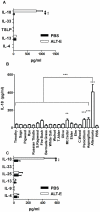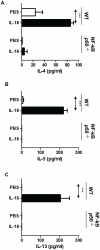Alternaria-induced release of IL-18 from damaged airway epithelial cells: an NF-κB dependent mechanism of Th2 differentiation?
- PMID: 22347372
- PMCID: PMC3274547
- DOI: 10.1371/journal.pone.0030280
Alternaria-induced release of IL-18 from damaged airway epithelial cells: an NF-κB dependent mechanism of Th2 differentiation?
Abstract
Background: A series of epidemiologic studies have identified the fungus Alternaria as a major risk factor for asthma. The airway epithelium plays a critical role in the pathogenesis of allergic asthma. These reports suggest that activated airway epithelial cells can produce cytokines such as IL-25, TSLP and IL-33 that induce Th2 phenotype. However the epithelium-derived products that mediate the pro-asthma effects of Alternaria are not well characterized. We hypothesized that exposure of the airway epithelium to Alternaria releasing cytokines that can induce Th2 differentiation.
Methodology/principal finding: We used ELISA to measure human and mouse cytokines. Alternaria extract (ALT-E) induced rapid release of IL-18, but not IL-4, IL-9, IL-13, IL-25, IL-33, or TSLP from cultured normal human bronchial epithelial cells; and in the BAL fluids of naïve mice after challenge with ALT-E. Both microscopic and FACS indicated that this release was associated with necrosis of epithelial cells. ALT-E induced much greater IL-18 release compared to 19 major outdoor allergens. Culture of naïve CD4 cells with rmIL-18 induced Th2 differentiation in the absence of IL-4 and STAT6, and this effect was abrogated by disrupting NF- κB p50 or with a NEMO binding peptide inhibitor.
Conclusion/significance: Rapid and specific release of IL-18 from Alternaria-exposed damaged airway epithelial cells can directly initiate Th2 differentiation of naïve CD4(+) T-cells via a unique NF-κB dependent pathway.
Conflict of interest statement
Figures





References
-
- WHO. World Health Organization (2007) Global Surveillance, Prevention and Control of Chronic Respiratory Diseases: A Comprehensive Approach. 1st ed. World Health Organization; 2007.
-
- Gergen PJ, Turkeltaub PC. The association of individual allergen reactivity with respiratory disease in a national sample: data from the second National Health and Nutrition Examination Survey, 1976–80 (NHANES II). J Allergy Clin Immunol. 1992;90:579–588. - PubMed
-
- Nelson HS, Szefler SJ, Jacobs J, Huss K, Shapiro G, et al. The relationships among environmental allergen sensitization, allergen exposure, pulmonary function, and bronchial hyperresponsiveness in the Childhood Asthma Management Program. J Allergy Clin Immunol. 1999;104:775–785. - PubMed
Publication types
MeSH terms
Substances
Grants and funding
- R01-ES018948/ES/NIEHS NIH HHS/United States
- UL1 TR000071/TR/NCATS NIH HHS/United States
- R01 ES018948/ES/NIEHS NIH HHS/United States
- N01-HV 00245/HV/NHLBI NIH HHS/United States
- P30 ES006676/ES/NIEHS NIH HHS/United States
- P01 AI062885/AI/NIAID NIH HHS/United States
- R01HL071163/HL/NHLBI NIH HHS/United States
- P30-ES006676/ES/NIEHS NIH HHS/United States
- R01 HL071163/HL/NHLBI NIH HHS/United States
- UL1 RR029876/RR/NCRR NIH HHS/United States
- P01AI062885-01/AI/NIAID NIH HHS/United States
- UL1RR029876/RR/NCRR NIH HHS/United States
LinkOut - more resources
Full Text Sources
Research Materials
Miscellaneous

